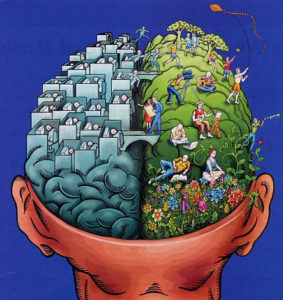Ever heard the joke “Left-handed people are the only people in their right minds”?  Roger Sperry, who won a Nobel prize in 1981 for his work with split-brain research, is responsible for much of our understanding of how the two halves of the brain control different functions. In summarising some of his findings, Sperry wrote “The main theme to emerge… is that there appear to be two modes of thinking, verbal and nonverbal, represented rather separately in left and right hemispheres respectively and that our education system, as well as science in general, tends to neglect the nonverbal form of intellect. What it comes down to is that modern society discriminates against the right hemisphere” (taken from “Left Brain Right Brain” by Dan Eden).
Roger Sperry, who won a Nobel prize in 1981 for his work with split-brain research, is responsible for much of our understanding of how the two halves of the brain control different functions. In summarising some of his findings, Sperry wrote “The main theme to emerge… is that there appear to be two modes of thinking, verbal and nonverbal, represented rather separately in left and right hemispheres respectively and that our education system, as well as science in general, tends to neglect the nonverbal form of intellect. What it comes down to is that modern society discriminates against the right hemisphere” (taken from “Left Brain Right Brain” by Dan Eden).
This concept should influence for the way we present biblical truth. Take evangelism, for instance. Most evangelistic methods are aimed at the left-brain, involving carefully crafted steps leading to the logical conclusion of a decision for Christ. In Rage against God, Peter Hitchens tells of his conversion from atheism to Christianity. I was intrigued to learn that it was a painting that arrested his attention towards Christ. It was not a powerful sermon, a thoughtful tract or a clever polemic that turned an atheist away from his “rage against God” towards faith. It was a beautiful work of art. Are we prepared to explore more creative avenues for gospel communication in order to connect with the more right-brained members of our communities and churches?
Jesus Himself used stories and word pictures to help people grasp eternal truths. He placed a little child on His lap and gave His hearers (and see-ers) food for thought about how to receive the kingdom of God. Water at a well, wheat in the hand, and giant temple stones were some of the myriad of non-verbals that Jesus used to draw people’s attention to truth. He used words, yes, but also the rich texture of images—each image added to the big mosaic of truth that Jesus was constantly developing with His teachings and life. Pulpit ministry, necessary as it is, can be enhanced by other avenues of the gospel message. Music, drama, dance, poetry, art, design, stories, food and object lessons enliven the impact of our spoken messages in a way that connects with the more intuitive amongst us.
Thinking outside the box about how to share God’s truth with others can involve many more “teachers” than just those verbally gifted. Perhaps I cannot present a lawyer’s logic when I share the gospel with a coworker, but I can confidently share an image that has brought biblical light to my soul. Perhaps an artist or musician in the congregation can breathe creative meaning into a much-repeated spiritual message. Decorators and dramatists, choreographers and food technicians–all have something to contribute to the greater picture of biblical truth. God can use my talents, even if they are right-brain dominant. Maybe especially so.
From the bassinet to the hospice, the creative arts pack an impact that can reach beyond the limits of mere words. Sensory-loaded Bible truths seep through the arguments of the brain and speak to the soul. For the right-brain dominant, those images and sounds may be the pathway to true understanding.
About Jane Gibb
